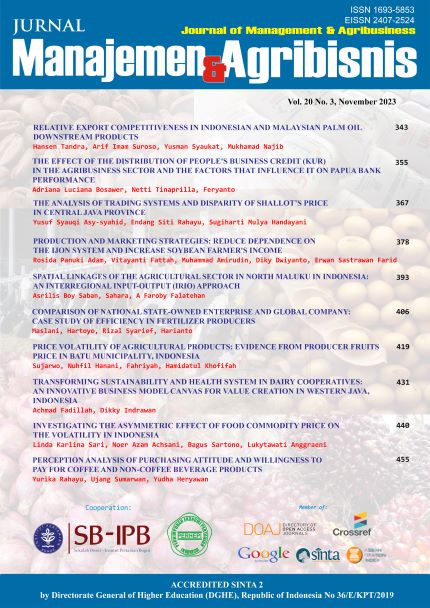Spatial Linkages of The Agricultural Sector in North Maluku in Indonesia: An Interregional Input-Output (IRIO) Approach
Abstract
The purpose of this study was to analyze the linkages between the agricultural sector and other sectors in North Maluku and the linkages between the North Maluku agricultural sector and other economic sectors in 33 provinces in Indonesia. The data used is the 2016 Indonesia Interregional Input-Output (IRIO) Table data. Linkage analysis, forward linkages effect ratio (IDP) and backward linkages effect ratio (IDK) analysis in the IRIO approach were used to answer the research objectives. The results of the analysis show the forward and backward linkages of the agricultural sector in North Maluku with the highest rank in the food crops and livestock subsector. The IDP and IDK results show that food crops and fisheries are stronger in encouraging the development of downstream industries, while livestock is stronger in encouraging the development of upstream industries in North Maluku. The North Maluku agricultural sector that has the highest total forward linkages between regions is the plantation subsector with North Sumatra Province. The highest total backward linkage is the crop subsector with East Kalimantan. The results of this study should have implications for the evaluation process, and policy formulation of the North Maluku Regional Government. Especially the development of the agricultural sector as an input and output provider aspect. The government is expected to focus on cooperation policies between regions related to trade and market expansion in the agricultural sector.
Keywords: sectoral linkages, regional linkages, agricultural sector, Interregional Input-Output (IRIO)
Authors
Authors who publish with this journal agree to the following terms:
- Authors retain copyright and grant the journal right of first publication with the work simultaneously licensed under a Creative Commons Attribution License that allows others to share the work with an acknowledgement of the work's authorship and initial publication in this journal.
- Authors are able to enter into separate, additional contractual arrangements for the non-exclusive distribution of the journal's published version of the work (e.g., post it to an institutional repository or publish it in a book), with an acknowledgement of its initial publication in this journal.
- Authors are permitted and encouraged to post their work online (e.g., in institutional repositories or on their website) prior to and during the submission process, as it can lead to productive exchanges, as well as earlier and greater citation of published work (See The Effect of Open Access).

